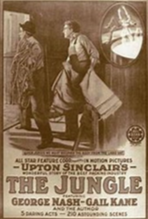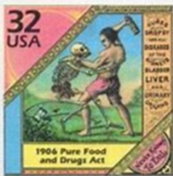In 1906, an American novelist and journalist by the name of Upton Sinclair wrote his polarizing novel The Jungle. The book showcased the harsh realities of Chicago and industrialized cities, including the living conditions and exploitation of immigrants. Part of his novel explored the meat industry, and he hoped by showing how horrible the work environment was he could gain support for socialism in the US. Instead it resulted in public outrage over the health violations and unsanitary practices exposed.
Sinclair was a “muckraker”, a journalist who exposed government and business corruption. For his book, he spent 7 weeks undercover in the meatpacking plants of Chicago. His final product told the fictional story of Jurgis Rudkus, a Lithuanian immigrant who came for the American Dream and instead found tragedy, death, and exploitation. The true moral of the tale, per Sinclair, was that Rudkus turned to socialism and found his life improved.

Passages in the book went into graphic detail about the state of meatpacking industries, which is what led to public outcry. Some of these stomach-turning bits included the prevalence of rotten meat being sold to the public, how chemicals, dirt, and sawdust were used as meat-filler, the shocking numbers of rat infestations in factories, and how laborers would fall into vats and be turned into lard. An example passage is below:
“There would be meat that had tumbled out on the floor, in the dirt and sawdust, where the workers had tramped and spit uncounted billions of consumption germs. There would be meat stored in great piles in rooms; and the water from leaky roofs would drip over it, and thousands of rats would race about on it. It was too dark in these storage places to see well, but a man could run his hand over these piles of meats and sweep off handfuls of the dried dung of rats. These rats were nuisances, and the packers would put poisoned bread out for them; they would die, and then the rats, bread, and meat would go into the hoppers together. This is no fairy story and no joke; the meat would be shoveled into carts, and the man who did the shoveling would not trouble to lift out a rat even when he saw one–there were things that went into the sausage in comparison with which a poisoned rat was a tidbit.”
Prior to its release, there had been close to 100 bills created to regulate food and drugs. These all sat in Congress for decades. The Jungle finally gave the push these bills needed. The current president, Theodore Roosevelt, was not Sinclair’s biggest fan and thought of him as a “crackpot” because of his socialist ideals. However, he ordered the US Department of Agriculture to investigate the claims made. While the USDA reported back that it was all lies, Roosevelt had suspicions concerning the USDA and its ties to the meatpacking industry. Behind the scenes, Roosevelt had his own secret investigators, Labor Commissioner Charles P. Neill and social worker James B. Reynolds, do an inspection. Surprise, surprise-their findings came back in support of what Sinclair had reported.
With this evidence, Congress was able to finally pass the Pure Food and Drug Act and the Meat Inspection Act in June 1906. These two monumental bills helped to keep food products from being mislabeled and adulterated, and became the building block for all future consumer protection legislation. Labels needed to clearly state ingredients, including variations. Ingredients that would conceal damage, act as a substitute for food, pose a health hazard, or could constitute a decomposed or dirty substance were prohibited. Food and drug labeling could not be misleading or false. Additionally, the presence and amount of 11 dangerous ingredients had to be listed, including morphine, caffeine, opium, cocaine, and cannabis. The Meat Inspection Act was assigned to the Food Safety and Inspection Service within the USDA. The Pure Food and Drug Act was also given oversight within the USDA by the Bureau of Chemistry. This agency was eventually renamed in 1930. That new name was the Food and Drug Administration (FDA), a name those of us in clinical research all know and love.

The current FDA has certainly grown since 1906. Their responsibilities in protecting the public health are expansive. They regulate about 78% of the US food supply, have approved over 20,000 prescription drug products for marketing, and oversee 6,700 medical device product categories among many, many things. FDA- regulated products account for 20 cents of every dollar spent in the US by consumers so most people have been impacted in some way by the FDA and the work they do. The FDA can be terrifying, especially for those in research. However, we are all much safer because of their extreme regulations and standards. I’ll take that over rat-burgers any day!
– Written by Kristin Powers, Senior Clinical Research Coordinator
Sources:
Pure Food and Drug Act – Wikipedia
Part I: The 1906 Food and Drugs Act and Its Enforcement | FDA
Fact Sheet: FDA at a Glance | FDA
7 Things You May Not Know About ‘The Jungle’ – HISTORY
Excerpt from The Jungle by Upton Sinclair: Guiding Questions (commonlit.org)